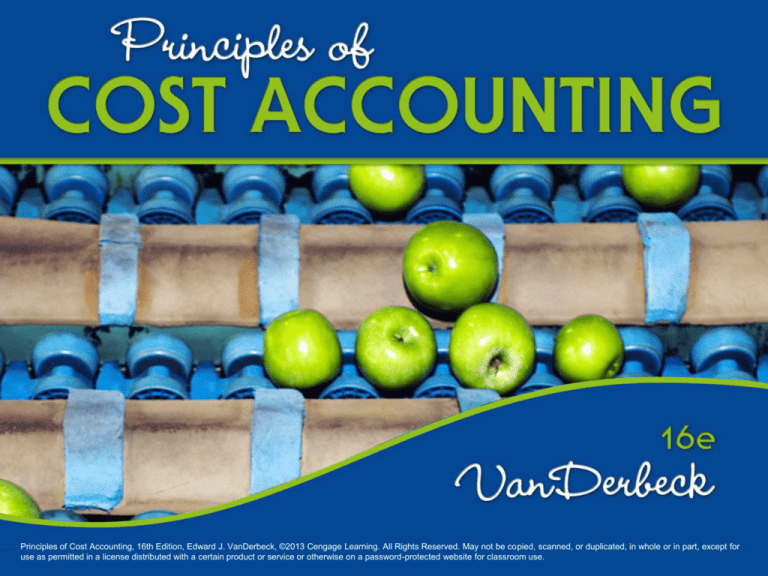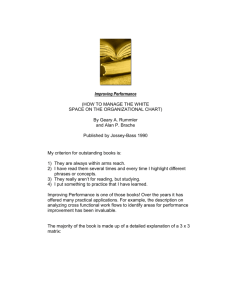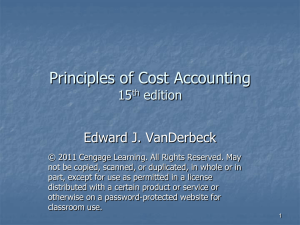
Principles of Cost Accounting, 16th Edition, Edward J. VanDerbeck, ©2013 Cengage Learning. All Rights Reserved. May not be copied, scanned, or duplicated, in whole or in part, except for
use as permitted in a license distributed with a certain product or service or otherwise on a password-protected website for classroom use.
Chapter 5
Process Cost AccountingGeneral Procedures
Learning Objectives
Recognize the differences between job
order and process cost accounting
systems.
Compute unit costs in a process cost
system.
Assign costs to inventories, using
equivalent units of production with the
average cost method.
Learning Objectives (cont.)
Prepare a cost of production summary
and journal entries for one department
with no beginning inventory.
Prepare a cost of production summary
and journal entries for one department
with beginning inventory.
Prepare a cost of production summary
and journal entries for multiple
departments with no beginning inventory.
Learning Objectives (cont.)
Prepare a cost of production summary
and journal entries for multiple
departments with beginning inventory.
Prepare a cost production summary with
a change in prior department’s unit
transfer cost.
Comparison of Basic Cost
Systems
• A job order cost system is appropriate
when differentiated products or services
are provided on a special-order basis.
• The focal point of a job order cost system
is the job.
Comparison of Basic Cost
Systems
• A process cost system is used when
goods or services of a similar nature are
provided.
• The focus of a process cost system is the
cost center to which costs are assigned.
• The primary objectives, are to compute the
unit cost of the products completed and
the cost to be assigned to the ending work
in process inventory.
Materials and Labor Costs
• Under a process cost system, the costs of
materials and labor are charged directly to
the departments in which they are
incurred.
• Indirect materials that cannot be directly
associated with a particular department
are charged to Factory Overhead.
• The focus of the process cost system is
the factory cost center.
Product Cost in a Process
Cost System
• The unit cost in each department is
calculated by dividing the total cost
charged to the department by the number
of units produced during the period.
• The total cost of each unit finished equals
the combined unit costs of all departments
used in the manufacture of the product.
Product Cost in a Process
Cost System
• Products accumulate costs as they pass
through each successive production
department.
• Departments record costs according to
the following procedure:
1. the costs of materials, labor, and factory
overhead directly identifiable with a
department are charged to the
department.
Product Cost in a Process
Cost System
2. the costs of the factory services
departments are allocated to the
production departments.
3. the costs added by prior production
departments are carried over to
successive departments.
Product Cost in a Process
Cost System
Work in Process Inventories
• The primary problem in inventory costing
is the allocation of total costs between
units finished during the period and units
still in process at the end of the period.
• The calculation of the degree of
completion of unfinished work in process
presents one of the most important and
difficult challenges in process costing.
Work in Process Inventories
• A factory will have units in varying stages
of completion:
1. Units started in a prior period and
completed during the current period.
2. Units started and finished during the
current period.
3. Units started during the current period
but not finished by the end of the period.
Allocating Total Costs
• Total Cost must be allocated between:
• Units finished during the period
• Units still in process at the end of the period
• Two procedures are commonly used for
assigning costs:
• Average Cost Method
• First in, first out Method
Equivalent Production
• Equivalent production represents the
number of whole units that could have
been completed during a period, given
amount of work that was performed.
• Stage of completion represents the
fraction or percentage of materials, labor,
and overhead costs of a completed unit
that has been applied to goods that have
not been completed by the end of the
month.
Production Report
• A production report shows the following:
1. Number of units in the beginning work in
process.
2. Number of units completed.
3. Number of units in the ending work in
process and their estimated stage of
completion.
Calculation of Equivalent
Units
Cost of Production Summary
One Department
• The reporting of production and
related costs in each department
involves the following:
1. Accumulating costs for which the department
is accountable.
2. Calculating equivalent production for the
period.
3. Computing the unit cost for the period.
4. Summarizing the disposition of the production
costs.
Cost of Production Summary
Multiple departments
• When there is more than one department, it
is necessary to keep separate control
accounts in the general ledger for recording
the costs of operating each department.
• A cost of production summary must be
prepared for each department along with
separate journal entries to record the
operations of each department and the
transfer of costs.
Cost of Production Summary
Multiple Departments
• Costs accumulated in each department
are transferred to the next department in
the production cycle.
• The transferred units and their related
costs are treated as completed units in the
one department and as raw materials in
the next department.
Cost of Production Summary
Multiple Departments
• The transferred-in costs and units from the
prior department are not included in the
calculation of unit cost and equivalent units
on the next department’s cost of production
summary.
• If there is still another department, the first
department’s costs must be considered in
transferring cost to the next department.
• The first department’s costs are also
considered in the costing of the ending work
in process inventory in the second
department.
Changes in Prior
Department’s unit Transfer
cost
• A prior department’s transfers from two
different periods will often have different unit
costs each month.
• The previous department costs must be
averaged as a separate grouping so that
these transferred-in costs can be properly
allocated to the products being produced in
the department.









